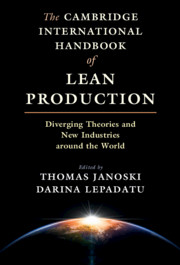 The Cambridge International Handbook of Lean Production
The Cambridge International Handbook of Lean Production Book contents
- The Cambridge International Handbook of Lean Production
- The Cambridge International Handbook of Lean Production
- Copyright page
- Dedication
- Contents
- Tables
- Figures and Sidebars
- Preface
- Acknowledgments
- Contributors
- Abbreviations
- 1 Lean Production as the Dominant Division of Labor
- Part I Theories of Lean Production
- Part II Lean Production across Industries
- 7 Challenges to Lean Implementation from a True Lean Toyota Production System Perspective
- 8 Lean Production in the Automotive Industry
- 9 Product and Process Innovation to Power the Lean Enterprise
- 10 Using a Lean Six Sigma Strategy to Be Resilient in the Telecommunications Sector
- 11 Lean Transformation in Healthcare
- 12 The Adoption of Lean Thinking by Legal Services Providers
- 13 Lean in Public Services
- 14 Mass Merchandizing and Lean Production at Walmart, Costco, and Amazon
- 15 Lean Management Systems and the Use of Financial Information
- 16 Lean Workflow and Quality Assurance when Creating Software-Intensive Products and Services
- Part III Lean Production Around the World
- Name Index
- Subject Index
- References
8 - Lean Production in the Automotive Industry
Origin, Diffusion, Paradoxes, and Contradictions of a New Managerial Paradigm
from Part II - Lean Production across Industries
Published online by Cambridge University Press: 11 March 2021
- The Cambridge International Handbook of Lean Production
- The Cambridge International Handbook of Lean Production
- Copyright page
- Dedication
- Contents
- Tables
- Figures and Sidebars
- Preface
- Acknowledgments
- Contributors
- Abbreviations
- 1 Lean Production as the Dominant Division of Labor
- Part I Theories of Lean Production
- Part II Lean Production across Industries
- 7 Challenges to Lean Implementation from a True Lean Toyota Production System Perspective
- 8 Lean Production in the Automotive Industry
- 9 Product and Process Innovation to Power the Lean Enterprise
- 10 Using a Lean Six Sigma Strategy to Be Resilient in the Telecommunications Sector
- 11 Lean Transformation in Healthcare
- 12 The Adoption of Lean Thinking by Legal Services Providers
- 13 Lean in Public Services
- 14 Mass Merchandizing and Lean Production at Walmart, Costco, and Amazon
- 15 Lean Management Systems and the Use of Financial Information
- 16 Lean Workflow and Quality Assurance when Creating Software-Intensive Products and Services
- Part III Lean Production Around the World
- Name Index
- Subject Index
- References
Summary
In the late 1970s, the landscape of the global automotive industry provided a stark contrast: Western car manufacturers were struggling in shrinking markets, closing dozens of plants, and laying off hundreds of thousands of workers; while the success of Japanese car manufacturers benefited from phenomenal export growth that seemed unlikely to stop. How can one explain such a reversal in the global fortunes of automotive production and how should nations and workers deal with it?
- Type
- Chapter
- Information
- The Cambridge International Handbook of Lean ProductionDiverging Theories and New Industries around the World, pp. 204 - 226Publisher: Cambridge University PressPrint publication year: 2021
References
- 2
- Cited by


